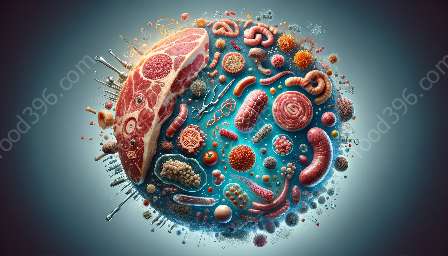Meat microbiology is a fascinating field that delves into the intricate world of microbial flora present in meat. Understanding the diverse communities of bacteria and other microorganisms in meat is crucial for both food safety and preservation. This topic cluster provides an in-depth exploration of microbial flora in meat, shedding light on its relevance to meat science and microbiology.
The Importance of Microbial Flora in Meat
Microbial flora in meat refers to the diverse array of bacteria, fungi, and other microorganisms that naturally inhabit meat. While some of these microbes can pose potential food safety risks, many play integral roles in the aging, flavor development, and preservation of meat products.
Significance in Meat Microbiology: Understanding the composition and behavior of microbial flora in meat is crucial for meat microbiologists. It involves studying the types of microbes present, their interactions, and their impact on meat quality and safety.
Role in Meat Science: In the realm of meat science, the microbial flora in meat influences the sensory attributes, shelf-life, and safety of meat products. Researchers and industry professionals in meat science work to harness the beneficial aspects of these microorganisms while mitigating potential risks.
The Composition of Microbial Flora in Meat
The microbial flora in meat is incredibly diverse, comprising various species of bacteria, yeasts, molds, and other microorganisms. These can be broadly categorized into beneficial, spoilage-causing, and pathogenic microbes.
Beneficial Microbes:
Beneficial microbes, such as certain lactic acid bacteria, contribute to the fermentation and preservation of meat products. They can enhance the flavor, texture, and safety of cured meats, including sausages and salami, through processes like lactic acid fermentation.
Spoilage-Causing Microbes:
Spoilage-causing microbes encompass a range of bacteria, yeasts, and molds that can lead to undesirable changes in meat, including off-flavors, odors, and texture deterioration. Common examples include Pseudomonas, Brochothrix thermosphacta, and various molds.
Pathogenic Microbes:
Pathogenic microbes, such as certain strains of Salmonella, Escherichia coli, and Listeria monocytogenes, pose significant food safety concerns when present in meat. Proper handling, processing, and storage are critical to prevent the proliferation of these pathogens.
Microbial Flora and Food Safety
Ensuring the safety of meat products is a top priority in the meat industry. Understanding the dynamics of microbial flora in meat is pivotal for maintaining food safety standards and preventing foodborne illnesses.
Microbial Contamination: Meat can become contaminated with pathogenic microbes during various stages of production, from animal processing to retail. This highlights the importance of stringent sanitation practices and proper handling throughout the supply chain.
Pathogen Control: Meat microbiologists and food scientists constantly develop and refine strategies to control and eliminate pathogenic microbes in meat, including using antimicrobial interventions and implementing strict hygiene protocols.
Regulatory Compliance: Government agencies and industry bodies enforce regulations and guidelines to ensure the safety of meat products. These include standards for microbial limits and the use of hazard analysis and critical control points (HACCP) to manage food safety risks.
Preservation and Fermentation
Microbial flora plays a crucial role in the preservation and fermentation of meat products, particularly in the context of cured and fermented meats. This natural and controlled microbial activity contributes to the development of unique flavors and textures in traditional meat products.
Lactic Acid Fermentation: Certain lactic acid bacteria, such as Lactobacillus and Pediococcus species, are instrumental in the fermentation of sausage and other cured meats. They convert sugars to lactic acid, which helps create a tangy flavor and inhibits the growth of spoilage and pathogenic microbes.
Mold-Ripened Products: Mold-ripened meats, like certain types of salami and hams, rely on controlled mold growth for flavor development and protection against unwanted microbes. Modern techniques carefully manage these microbial processes, balancing tradition with food safety.
Emerging Research and Innovations
As technology advances and scientific knowledge expands, ongoing research and innovation in meat microbiology and science continue to shape the understanding and management of microbial flora in meat.
Next-Generation Sequencing: Techniques like metagenomic sequencing allow researchers to analyze the complete genetic content of microbial communities in meat, providing insights into the diversity and dynamics of microorganisms.
Probiotic Meat Products: There is growing interest in developing meat products enriched with probiotic bacteria, which can confer health benefits to consumers while influencing the microbial flora in meat towards a desirable composition.
Conclusion
The study of microbial flora in meat is an ever-evolving field with profound implications for both meat science and microbiology. By comprehensively understanding the microbial communities present in meat and harnessing their beneficial aspects while mitigating potential risks, researchers and industry professionals can continue to advance the safety, quality, and diversity of meat products.

